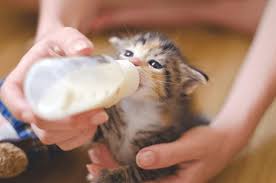Caring for Orphaned Kittens: A Complete Guide to Giving Them the Best Start
Caring for orphaned kittens is a demanding but incredibly rewarding experience. These tiny, vulnerable creatures require round-the-clock attention and specialized care to survive and thrive. Without a mother cat, you become their sole provider, taking on the roles of warmth provider, food source, and groomer. This guide provides a comprehensive overview of how to successfully nurture orphaned kittens, giving them the best possible chance at a healthy and happy life.
Initial Assessment and Preparation
Before diving into the daily routine, a thorough assessment of the kitten’s condition is crucial. Observe their activity level, body weight, and overall health. Look for signs of illness like discharge from the eyes or nose, diarrhea, vomiting, or difficulty breathing. If possible, take them to a veterinarian for a check-up, deworming, and flea treatment (ensure the treatment is safe for young kittens!).
Preparation is key. You’ll need a warm, safe environment for the kittens. A cardboard box lined with soft blankets or towels works well as a temporary nest, but a more permanent setup can be made with a plastic carrier or a large bin. Keep the temperature in the box consistently warm, ideally between 85-90°F for the first week, gradually decreasing to 70-75°F by four weeks of age. A heating pad specifically designed for pets, wrapped in a towel to prevent direct contact, is an excellent way to maintain the correct temperature. Avoid using human heating pads, as they can overheat and pose a burn risk.
The Importance of Proper Feeding
Feeding orphaned kittens requires strict adherence to a schedule and the use of kitten milk replacer (KMR). Cow’s milk is not suitable for kittens and can cause digestive upset. KMR is specifically formulated to meet the nutritional needs of growing kittens.
- Feeding Schedule: Newborn kittens need to be fed every 2-3 hours around the clock for the first week. Gradually increase the intervals to every 4 hours by two weeks of age. From three weeks onward, you can reduce feedings to 5-6 times a day.
- Feeding Techniques: Use a specialized kitten nursing bottle or a syringe (without the needle). Hold the kitten in a comfortable, upright position, similar to how they would nurse from their mother. Gently insert the nipple or syringe tip into the kitten’s mouth and allow them to suckle at their own pace. Avoid forcing the milk, as this can lead to aspiration (milk entering the lungs).
- Burping: After each feeding, gently pat the kitten on the back, just like you would burp a baby.
- Monitoring Weight: Regularly weigh the kittens to ensure they are gaining weight appropriately. A healthy kitten should gain approximately 0.5 ounces (15 grams) per day. Track their weight using a small kitchen scale. If they are not gaining weight or seem lethargic, consult with a veterinarian immediately.
Stimulating Elimination
Mother cats stimulate their kittens to urinate and defecate by licking their bottoms. Without a mother, you’ll need to replicate this process. After each feeding, gently massage the kitten’s anal and genital area with a warm, damp cloth or cotton ball. This action will encourage them to eliminate. Continue this stimulation until they are able to eliminate on their own, usually around 3-4 weeks of age.
Hygiene and Grooming
Keeping the kittens clean and groomed is essential for their health and well-being. Gently wipe them down with a damp cloth to remove any dirt or spills. Use a soft toothbrush to gently groom their fur, mimicking the grooming behavior of a mother cat. This also helps stimulate blood circulation and provides comforting interaction.
Transitioning to Solid Food
Around 3-4 weeks of age, you can begin introducing solid food. Start by offering a gruel made of KMR mixed with a small amount of high-quality wet kitten food. Gradually decrease the amount of KMR and increase the amount of wet food. By 5-6 weeks of age, they should be able to eat wet food on their own. You can then gradually introduce dry kitten food. Always ensure they have access to fresh, clean water.
Socialization and Enrichment
Caring for orphaned kittens involves more than just feeding and cleaning. Socialization is crucial for their development into well-adjusted cats. Handle the kittens gently and frequently, talking to them in a soft voice. Introduce them to different sights, sounds, and textures to help them become accustomed to their environment. Once they are a bit older and have been vaccinated, you can gradually introduce them to other animals and people.
Provide them with toys and opportunities to play. Small balls, stuffed mice, and feather wands are all great options. Playtime helps them develop their coordination, hunting skills, and social skills.
Potential Health Issues
Be vigilant for signs of illness. Common health problems in orphaned kittens include upper respiratory infections, eye infections, diarrhea, and fleas. If you notice any concerning symptoms, consult with a veterinarian immediately. Early intervention is key to improving their chances of recovery.
Conclusion
Raising orphaned kittens is a challenging but incredibly rewarding journey. By providing them with proper nutrition, hygiene, and socialization, you can give them the best possible start in life. Remember to be patient, attentive, and loving, and you’ll be rewarded with the joy of watching these tiny creatures grow into healthy, happy companions. Be prepared for sleepless nights and a lot of work, but know that your efforts are making a huge difference in their lives. Consider reaching out to local animal shelters or rescue organizations for support and guidance – they often have experienced volunteers who can offer valuable advice. With dedication and care, you can successfully nurture these vulnerable kittens and help them thrive.

